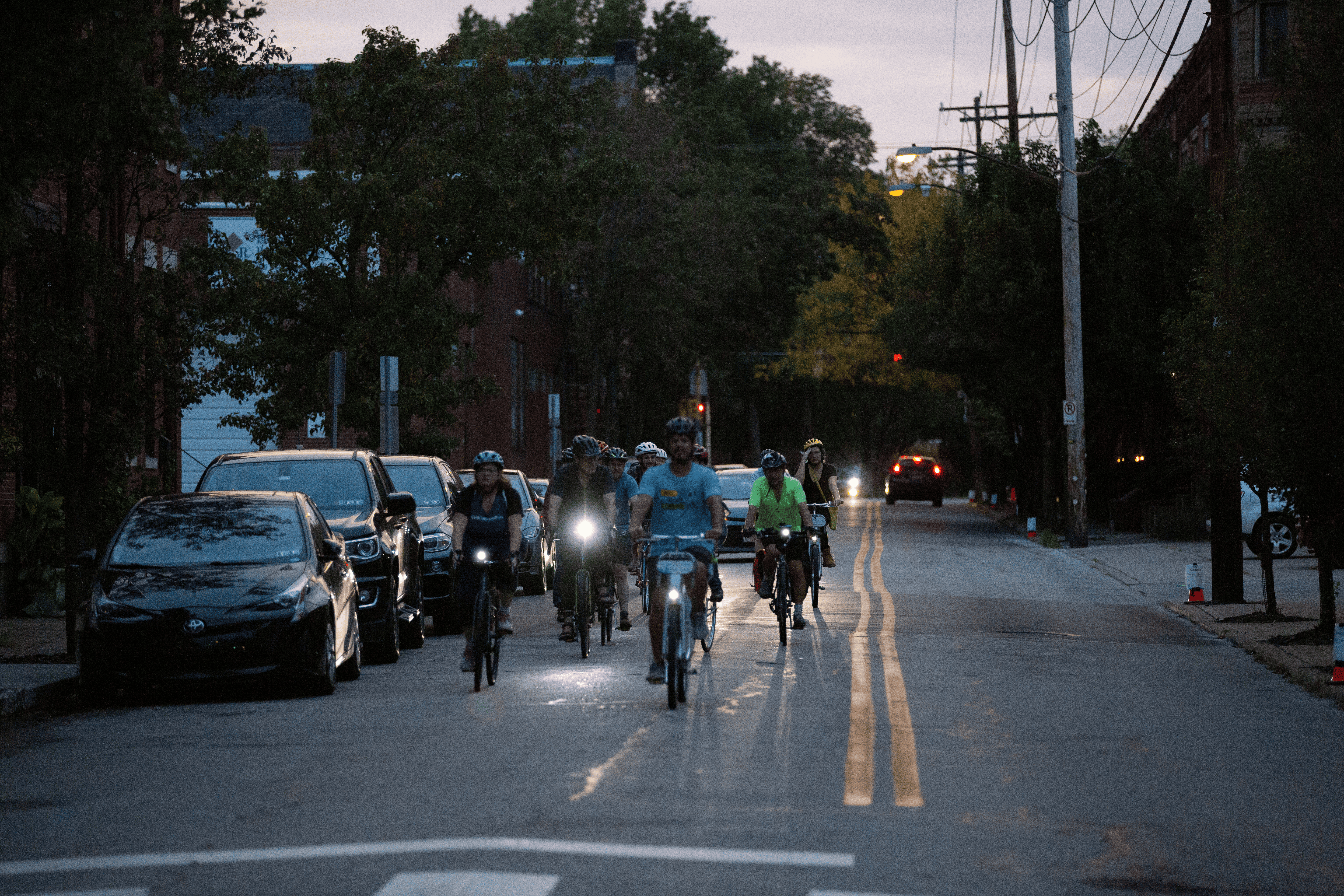
The time change doesn’t have to make your commute more stressful!
Daylight saving time ends at 2 a.m. on Sunday, November 7, and with it follows the dreaded shorter days and longer nights. Despite the shorter days, biking and walking are still great ways to get through the dark-before-six blues.
Unfortunately, Allegheny County crash data shows an increase in pedestrian crashes in the City of Pittsburgh during the months with the shortest days of the year. Here are some ways to stay safe on your commute in the darker season:
Safety tips for everyone
Shorter days mean more of us are commuting when visibility is especially bad. Here are some safety tips for people who walk, bike, and drive.
- Danger zone: Know that this is a more dangerous time of year for using our streets and keep that in the front of your mind. Be extra vigilant and cautious.
- Plan ahead: Commuters, as always, give yourself extra time to get where you need to go so that you won’t feel rushed.
- Enhance your vision: Although this time of year is often dreary, you should still prepare to deal with sun glare. Have sunglasses with polarized lenses at the ready, or wear eyeglasses with an anti-reflective (AR) coating.
PEDESTRIANS
- Dress to be seen: While more responsibility falls on the driver to drive at a safe speed and for the conditions, pedestrians can help drivers see them better by wearing lighter color or even reflective clothing. Prefer dark clothing? Balance it with a piece that is reflective or bright.
- Be aware: Don’t assume that a driver or bicyclist for that matter sees you. When crossing the street, be extra aware of drivers who are driving towards the sunrise or sunset, as they will have a harder time seeing you.
- Cross consciousness: Always cross at an intersection. Lighting is often better there, and at major intersections, there are typically pedestrian signals to follow and crosswalks to help you be seen.
- Scoot visibly: If you’re planning to take a rental scooter after dark, consider wearing bright or reflective clothing and wearing a helmet.
BICYCLISTS
- Make yourself visible: Wear reflective materials and/or bright-colored attire (A high visibility helmet, jacket, socks/shoes, and gloves are pieces you can obtain at a local bike shop). Reflective tape on your gloves helps others see hand signaling movement. Reflective tape or stickers for your bicycle or gear are also a great investment. A reflective pant strap can also keep your pant legs from getting caught in the chain.
- Illuminate: By PA law, bicycle riders must have at least a white headlight and a red rear reflector when riding in the dark. If you’re riding in the woods or in unlit areas consider a front light with at least 700 Lumens of brightness. An additional red rear blinking light is an even safer option. Battery-powered lights are inexpensive and common, but rechargeable lights are often brighter and more sustainable Want to never run out of juice? A generator hub and light set is an excellent solution for all-season riding. Have fun with it! Wheel-mounted lights or string LEDs are great ways to add some pizzazz to your ride!
- Test it out: It’s the law in PA that the reflector and lights should be visible for 500 feet. Take a friend and check each other from a distance to see just how visible you truly are.
- Assume drivers don’t see you: Err on the side of caution and never assume that the driver sees you, even when you have the right of way. Give traffic an extra look before crossing at intersections.
Did you know? Riding without lights not only makes bicyclists near-invisible after dark – it’s also a ticket-able offense. PA state law requires front lights and rear reflectors to be visible after dusk and before dawn. Lightless biking is risky, and whether people are simply unaware or cannot afford lights, we want to ensure that they are covered.
DRIVERS
- Be extra cautious: Decreased visibility calls for more vigilant driving. Keep your eyes peeled for bicyclists and pedestrians.
- Slow down and pass with care: Increase the recommended safe distances to allow three or more seconds between vehicles and bicyclists. The more space you have, the more time you have to react. Slow down around bicyclists and pedestrians and always give them extra space when passing. Always yield to pedestrians trying to cross the street.
- Beware of glare: Clean your windshield outside and inside. A cracked or dirty windshield can magnify glare. This also goes for your glasses and sunglasses. Be sure to have your sunglasses ready for sunrise and sunset or wet, snowy, or icy conditions.
- Be patient: Know that people who are walking or biking bundled up may not be able to hear or see you as well, and take more time to react or maneuver especially with wet or icy conditions. Honking can startle or alarm bicyclists creating a dangerous situation.